Qingxu Fu
Unreal-MAP: Unreal-Engine-Based General Platform for Multi-Agent Reinforcement Learning
Mar 20, 2025Abstract:In this paper, we propose Unreal Multi-Agent Playground (Unreal-MAP), an MARL general platform based on the Unreal-Engine (UE). Unreal-MAP allows users to freely create multi-agent tasks using the vast visual and physical resources available in the UE community, and deploy state-of-the-art (SOTA) MARL algorithms within them. Unreal-MAP is user-friendly in terms of deployment, modification, and visualization, and all its components are open-source. We also develop an experimental framework compatible with algorithms ranging from rule-based to learning-based provided by third-party frameworks. Lastly, we deploy several SOTA algorithms in example tasks developed via Unreal-MAP, and conduct corresponding experimental analyses. We believe Unreal-MAP can play an important role in the MARL field by closely integrating existing algorithms with user-customized tasks, thus advancing the field of MARL.
Self-Clustering Hierarchical Multi-Agent Reinforcement Learning with Extensible Cooperation Graph
Mar 26, 2024



Abstract:Multi-Agent Reinforcement Learning (MARL) has been successful in solving many cooperative challenges. However, classic non-hierarchical MARL algorithms still cannot address various complex multi-agent problems that require hierarchical cooperative behaviors. The cooperative knowledge and policies learned in non-hierarchical algorithms are implicit and not interpretable, thereby restricting the integration of existing knowledge. This paper proposes a novel hierarchical MARL model called Hierarchical Cooperation Graph Learning (HCGL) for solving general multi-agent problems. HCGL has three components: a dynamic Extensible Cooperation Graph (ECG) for achieving self-clustering cooperation; a group of graph operators for adjusting the topology of ECG; and an MARL optimizer for training these graph operators. HCGL's key distinction from other MARL models is that the behaviors of agents are guided by the topology of ECG instead of policy neural networks. ECG is a three-layer graph consisting of an agent node layer, a cluster node layer, and a target node layer. To manipulate the ECG topology in response to changing environmental conditions, four graph operators are trained to adjust the edge connections of ECG dynamically. The hierarchical feature of ECG provides a unique approach to merge primitive actions (actions executed by the agents) and cooperative actions (actions executed by the clusters) into a unified action space, allowing us to integrate fundamental cooperative knowledge into an extensible interface. In our experiments, the HCGL model has shown outstanding performance in multi-agent benchmarks with sparse rewards. We also verify that HCGL can easily be transferred to large-scale scenarios with high zero-shot transfer success rates.
Prioritized League Reinforcement Learning for Large-Scale Heterogeneous Multiagent Systems
Mar 26, 2024Abstract:Large-scale heterogeneous multiagent systems feature various realistic factors in the real world, such as agents with diverse abilities and overall system cost. In comparison to homogeneous systems, heterogeneous systems offer significant practical advantages. Nonetheless, they also present challenges for multiagent reinforcement learning, including addressing the non-stationary problem and managing an imbalanced number of agents with different types. We propose a Prioritized Heterogeneous League Reinforcement Learning (PHLRL) method to address large-scale heterogeneous cooperation problems. PHLRL maintains a record of various policies that agents have explored during their training and establishes a heterogeneous league consisting of diverse policies to aid in future policy optimization. Furthermore, we design a prioritized policy gradient approach to compensate for the gap caused by differences in the number of different types of agents. Next, we use Unreal Engine to design a large-scale heterogeneous cooperation benchmark named Large-Scale Multiagent Operation (LSMO), which is a complex two-team competition scenario that requires collaboration from both ground and airborne agents. We use experiments to show that PHLRL outperforms state-of-the-art methods, including QTRAN and QPLEX in LSMO.
Learning Heterogeneous Agent Cooperation via Multiagent League Training
Nov 13, 2022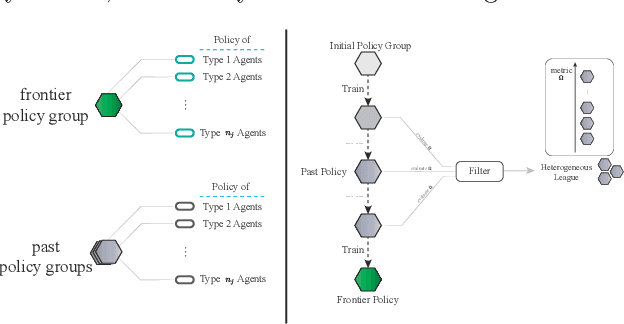
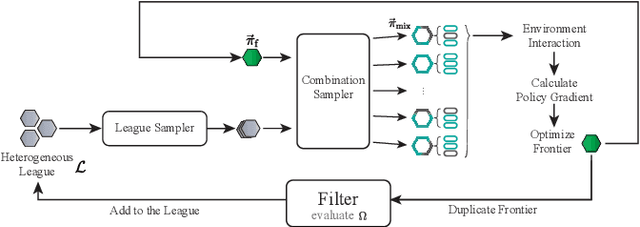
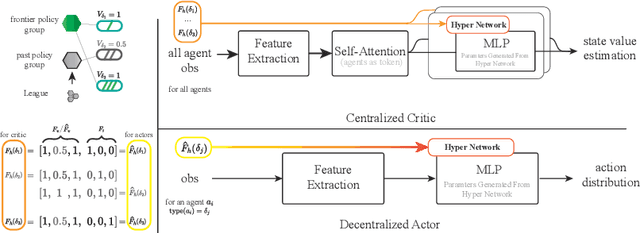

Abstract:Many multiagent systems in the real world include multiple types of agents with different abilities and functionality. Such heterogeneous multiagent systems have significant practical advantages. However, they also come with challenges compared with homogeneous systems for multiagent reinforcement learning, such as the non-stationary problem and the policy version iteration issue. This work proposes a general-purpose reinforcement learning algorithm named as Heterogeneous League Training (HLT) to address heterogeneous multiagent problems. HLT keeps track of a pool of policies that agents have explored during training, gathering a league of heterogeneous policies to facilitate future policy optimization. Moreover, a hyper-network is introduced to increase the diversity of agent behaviors when collaborating with teammates having different levels of cooperation skills. We use heterogeneous benchmark tasks to demonstrate that (1) HLT promotes the success rate in cooperative heterogeneous tasks; (2) HLT is an effective approach to solving the policy version iteration problem; (3) HLT provides a practical way to assess the difficulty of learning each role in a heterogeneous team.
Solving the Diffusion of Responsibility Problem in Multiagent Reinforcement Learning with a Policy Resonance Approach
Aug 19, 2022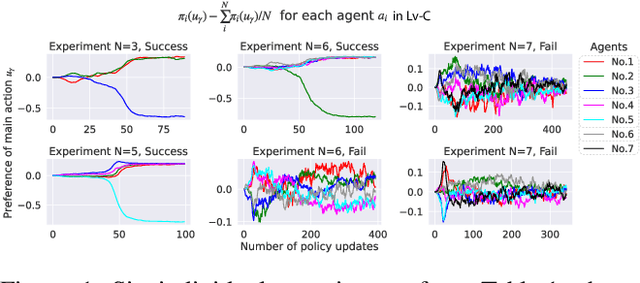

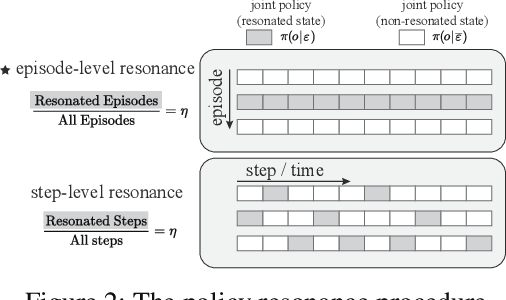

Abstract:SOTA multiagent reinforcement algorithms distinguish themselves in many ways from their single-agent equivalences, except that they still totally inherit the single-agent exploration-exploitation strategy. We report that naively inheriting this strategy from single-agent algorithms causes potential collaboration failures, in which the agents blindly follow mainstream behaviors and reject taking minority responsibility. We named this problem the diffusion of responsibility (DR) as it shares similarities with a same-name social psychology effect. In this work, we start by theoretically analyzing the cause of the DR problem, emphasizing it is not relevant to the reward crafting or the credit assignment problems. We propose a Policy Resonance approach to address the DR problem by modifying the multiagent exploration-exploitation strategy. Next, we show that most SOTA algorithms can equip this approach to promote collaborative agent performance in complex cooperative tasks. Experiments are performed in multiple test benchmark tasks to illustrate the effectiveness of this approach.
A Cooperation Graph Approach for Multiagent Sparse Reward Reinforcement Learning
Aug 05, 2022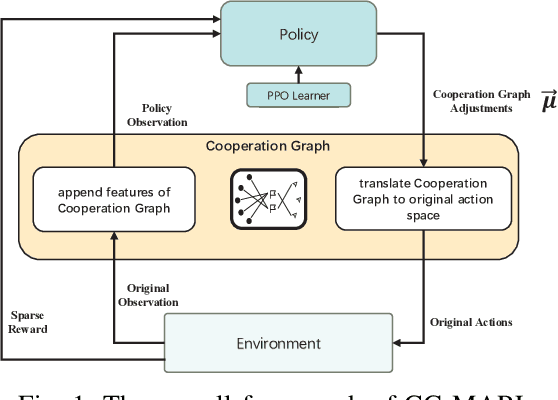
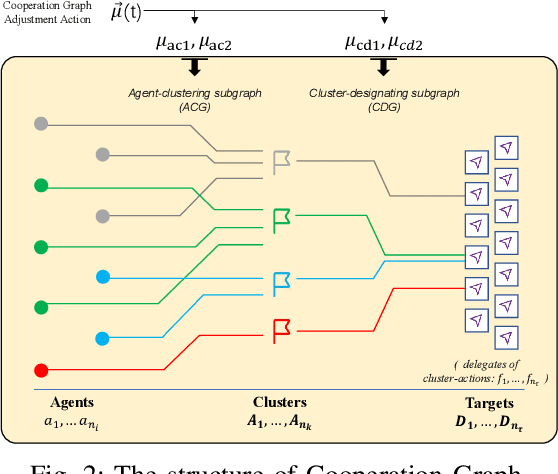
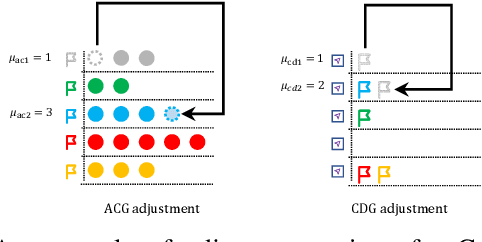
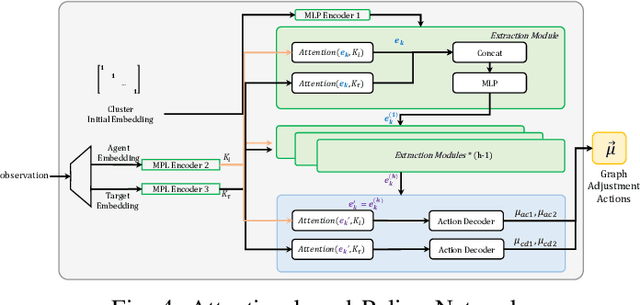
Abstract:Multiagent reinforcement learning (MARL) can solve complex cooperative tasks. However, the efficiency of existing MARL methods relies heavily on well-defined reward functions. Multiagent tasks with sparse reward feedback are especially challenging not only because of the credit distribution problem, but also due to the low probability of obtaining positive reward feedback. In this paper, we design a graph network called Cooperation Graph (CG). The Cooperation Graph is the combination of two simple bipartite graphs, namely, the Agent Clustering subgraph (ACG) and the Cluster Designating subgraph (CDG). Next, based on this novel graph structure, we propose a Cooperation Graph Multiagent Reinforcement Learning (CG-MARL) algorithm, which can efficiently deal with the sparse reward problem in multiagent tasks. In CG-MARL, agents are directly controlled by the Cooperation Graph. And a policy neural network is trained to manipulate this Cooperation Graph, guiding agents to achieve cooperation in an implicit way. This hierarchical feature of CG-MARL provides space for customized cluster-actions, an extensible interface for introducing fundamental cooperation knowledge. In experiments, CG-MARL shows state-of-the-art performance in sparse reward multiagent benchmarks, including the anti-invasion interception task and the multi-cargo delivery task.
Concentration Network for Reinforcement Learning of Large-Scale Multi-Agent Systems
Apr 07, 2022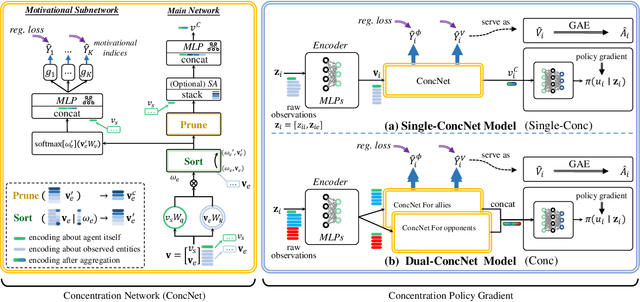


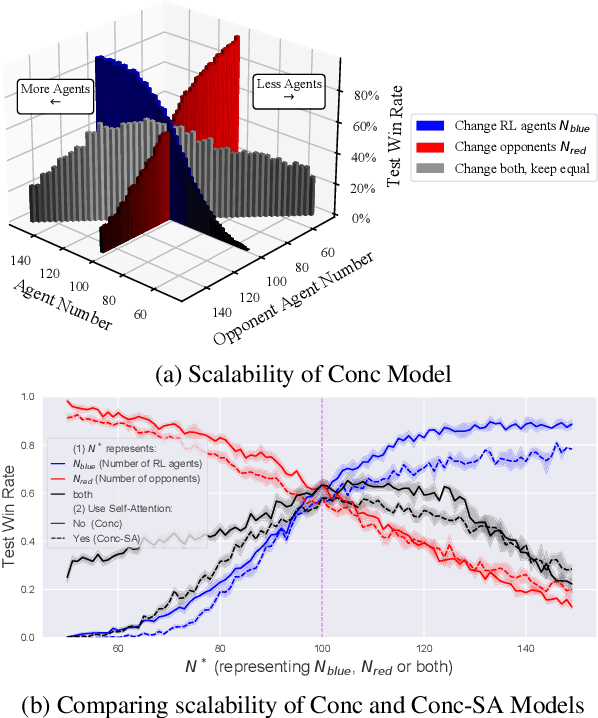
Abstract:When dealing with a series of imminent issues, humans can naturally concentrate on a subset of these concerning issues by prioritizing them according to their contributions to motivational indices, e.g., the probability of winning a game. This idea of concentration offers insights into reinforcement learning of sophisticated Large-scale Multi-Agent Systems (LMAS) participated by hundreds of agents. In such an LMAS, each agent receives a long series of entity observations at each step, which can overwhelm existing aggregation networks such as graph attention networks and cause inefficiency. In this paper, we propose a concentration network called ConcNet. First, ConcNet scores the observed entities considering several motivational indices, e.g., expected survival time and state value of the agents, and then ranks, prunes, and aggregates the encodings of observed entities to extract features. Second, distinct from the well-known attention mechanism, ConcNet has a unique motivational subnetwork to explicitly consider the motivational indices when scoring the observed entities. Furthermore, we present a concentration policy gradient architecture that can learn effective policies in LMAS from scratch. Extensive experiments demonstrate that the presented architecture has excellent scalability and flexibility, and significantly outperforms existing methods on LMAS benchmarks.
Learning an Adaptive Model for Extreme Low-light Raw Image Processing
Apr 22, 2020



Abstract:Low-light images suffer from severe noise and low illumination. Current deep learning models that are trained with real-world images have excellent noise reduction, but a ratio parameter must be chosen manually to complete the enhancement pipeline. In this work, we propose an adaptive low-light raw image enhancement network to avoid parameter-handcrafting and to improve image quality. The proposed method can be divided into two sub-models: Brightness Prediction (BP) and Exposure Shifting (ES). The former is designed to control the brightness of the resulting image by estimating a guideline exposure time $t_1$. The latter learns to approximate an exposure-shifting operator $ES$, converting a low-light image with real exposure time $t_0$ to a noise-free image with guideline exposure time $t_1$. Additionally, structural similarity (SSIM) loss and Image Enhancement Vector (IEV) are introduced to promote image quality, and a new Campus Image Dataset (CID) is proposed to overcome the limitations of the existing datasets and to supervise the training of the proposed model. Using the proposed model, we can achieve high-quality low-light image enhancement from a single raw image. In quantitative tests, it is shown that the proposed method has the lowest Noise Level Estimation (NLE) score compared with the state-of-the-art low-light algorithms, suggesting a superior denoising performance. Furthermore, those tests illustrate that the proposed method is able to adaptively control the global image brightness according to the content of the image scene. Lastly, the potential application in video processing is briefly discussed.
 Add to Chrome
Add to Chrome Add to Firefox
Add to Firefox Add to Edge
Add to Edge